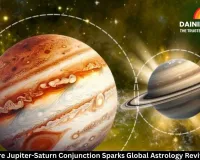Stargazing to Brain Scanning: How Astrology's Language Mirrors Modern Neuroscience
Digital Desk
.jpg)
For centuries, astrology has used a specific lexicon to describe human personality and destiny—terms like "hardwiring," "circuits," and "energy flow." Intriguingly, modern neuroscience, particularly through massive projects like the BRAIN Initiative , has begun to map the biological underpinnings of the self using strikingly similar concepts.
From Cosmic Circuits to Neural Networks
Astrology often speaks of individuals being "wired" a certain way, such as a mercurial Gemini having a quick-thinking mind or a deep Scorpio having intense emotional currents. Neuroscience is now providing a physical map for this concept. The primary focus of the BRAIN Initiative® is the analysis of complex neural circuits, aiming to understand how interacting neurons give rise to our thoughts, emotions, and behaviors . When an astrologer interprets how planetary energies might affect your mental "circuits," a neuroscientist is simultaneously working to "generate circuit diagrams that vary in resolution from synapses to the whole brain" .
The Dynamic Brain in Action
Another key area of overlap is the focus on dynamic patterns. Horoscopes frequently advise on the best times for action or reflection based on the moving planets, essentially commenting on the shifting internal "weather." In a parallel endeavor, one of the core goals of the BRAIN Initiative® is to "produce a dynamic picture of the functioning brain," observing how patterns of neural activity change in real-time to create the experience of life . Both fields, in their own ways, seek to understand the flux and flow that constitutes a conscious being.
A New Dialogue Between Ancient and Modern
While their methods and epistemological foundations are worlds apart, this conceptual convergence opens a fascinating dialogue. The intuitive language of astrology seems to have anticipated the structural and functional complexity that neuroscience is now proving. Understanding that our moods and tendencies have a tangible basis in the "stars" of our own brain—our neural pathways and chemical signals—can be a powerful step toward self-compassion and a more integrated understanding of what it means to be human.

.jpg)
.jpg)




.jpg)


1.jpg)
